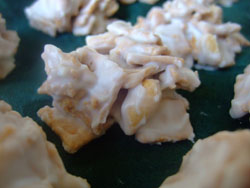Snowflakes
The following text is drawn from our featured Christmas book and is also available for free as audio.
 Christmas comes just four days after the winter season officially begins. Since snow most often falls during this time of year in the Northern hemisphere, snowflakes have naturally come to be associated with Christmas in America. Though the naked eye can rarely appreciate the intricate beauty of snowflakes, technology (like photomicroscopes) has given us a window through which to see God’s elegant designs.
Christmas comes just four days after the winter season officially begins. Since snow most often falls during this time of year in the Northern hemisphere, snowflakes have naturally come to be associated with Christmas in America. Though the naked eye can rarely appreciate the intricate beauty of snowflakes, technology (like photomicroscopes) has given us a window through which to see God’s elegant designs.
The first known snowflake photographer, Wilson Bentley (1865-1931), wrote this:
“Under the microscope, I found that snowflakes were miracles of beauty; and it seemed a shame that this beauty should not be seen and appreciated by others. Every crystal was a masterpiece of design and no one design was ever repeated. When a snowflake melted, that design was forever lost. Just that much beauty was gone, without leaving any record behind.”
Yet, the Bible teaches that snow does in fact leave a “record” behind, and it accomplishes the purpose for which God sent it. The book of Isaiah records God’s words as follows:
“As the heavens are higher than the earth, so are my ways higher than your ways and my thoughts than your thoughts. As the rain and the snow come down from heaven, and do not return to it without watering the earth and making it bud and flourish, so that it yields seed for the sower and bread for the eater, so is my word that goes out from my mouth: It will not return to me empty, but will accomplish what I desire and achieve the purpose for which I sent it.”
Additionally, believers need not fear that the beauty of snowflakes will be “forever lost.” Beauty comes from God. He himself is the full embodiment of beauty, and he is eternal. In fact, the very thing that makes things in nature marvelous is that they reveal something of their Creator. Henry David Thoreau, a famous 19th century American author, wrote of snowflakes in his journal:
“How full of the creative genius is the air in which these are generated! I should hardly admire them more if real stars fell and lodged on my coat. Nature is full of genius, full of the divinity: so that not a snowflake escapes its fashioning hand.”
Snowflakes surely reveal both God’s creative genius and his concern with even the smallest details on earth.
When most people think of a snowflake, they envision a multi-branched snow star. Though snowflakes come in a variety of patterns, one thing they all have in common is their six-sided structure. The hexagonal form of water molecules is essentially transferred to the geometry of a growing snow crystal, and in the case of a snow star, six somewhat symmetrical branches will emerge.
In some rare cases, three sides of the hexagon will grow larger than the other and produce a triangular looking crystal. In other rare cases, two crystals combine, either through a collision or through twinning, to produce a twelve-branched snowflake. However, one thing that is not found in nature is a snow crystal with four, five, seven or eight sides. The symmetry of the ice crystal does not allow these forms.
It is intriguing that God designed the structure of water molecules with six-fold symmetry. As an element so essential to life, water molecules carry in their form an allusion to the creation story.
The Bible teaches that “the heaven and the earth were completed in all their vast array” over a six day period. May the six-fold symmetry of the snowflake be a reminder of God’s mighty hand in the creation story!
Back to Main Christmas Symbols Page.
We welcome your questions and feedback. If you are seeking information on snowflakes that is not found on our website, please contact us.
This content has a copyright © 2008 by Angie Mosteller. Please cite the source if you use this material: http://www.celebratingholidays.com/?page_id=1589.






